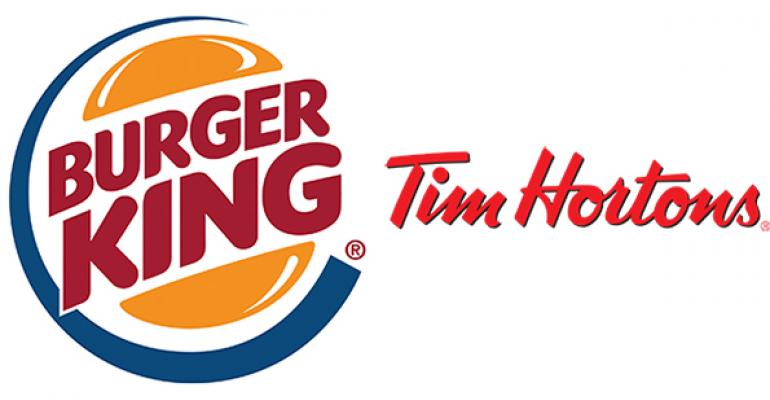Value promotions, premium menu items and a stronger economy helped Burger King’s first quarter same-store sales rise 6.9 percent in the U.S. and Canada, its best performance in nearly a decade, parent company Restaurant Brands International Inc. said Monday.
Burger King’s global same-store sales rose 4.6 percent during the quarter ended March 31, while sister brand Tim Hortons’ same-store sales rose 5.3 percent, including 8.9 percent in the U.S., where it is aiming to grow more quickly.
“We had strong [sales] growth across both our Tim Hortons and Burger King brands as we execute on brand-specific strategies to deliver value to all stakeholders,” Restaurant Brands International CEO Daniel Schwartz said during the company’s earnings call Monday. “We have made strong progress on a number of initiatives that will serve as a sturdy platform on which to build our business in 2015.”
The quarter was the first full period in which Burger King and Tim Hortons have operated under a single parent company since their $11 billion merger late last year. The Oakville, Ontario-based company is now the third largest restaurant operator in the world, after McDonald’s Corp. and Yum! Brands Inc.
Total revenue during the quarter was $932 million, an increase from $240.9 million the previous year, before the merger. The company reported an $8.1 million net loss in the quarter, partly due to expenses related to the merger, falling from a net profit of $60.4 million in the first quarter of 2014, before the merger.
The company’s stock rose 2 percent in Monday morning trading.
Brazilian private-equity firm 3G Capital controls Restaurant Brands International, and drove the merger largely because of the potential to expand Tim Hortons in the U.S. and in international markets.
Schwartz said the company is “in discussions with franchisees about accelerating the pace of Tim Hortons’ growth” in the U.S.
Under previous management, Tim Hortons shifted the brand’s development to a traditional franchisee-led model. The brand had traditionally controlled development, including real estate. New management has continued that shift. As sales and profit improve at Tim Hortons, operators become more interested in the brand.
“As our business is growing, unit profitability is getting stronger and the return on investment for Tim Hortons improves, we get more interest in expanding the Tim Hortons brand in the U.S.,” Schwartz said.
“It’s all about having the right partnership structure with the right operators,” he added.
Tim Hortons’ systemwide sales rose 8.1 percent in the first quarter, to $1.5 billion, before the impact of currency shifts.
At Burger King, systemwide sales rose 9.6 percent, to $4 billion, in the first quarter. The company reported same-store sales growth in all of its major markets, but sales rose only 0.7 percent in Europe due to economic weakness in Russia and Germany. Same-store sales rose 1.7 percent in Asia and 4.9 percent in Latin America.
Burger King’s strong same-store sales in the U.S. and Canada were due partly to easier comparisons. Its same-store sales the previous year rose only 0.1 percent. Executives also acknowledged that “macroeconomic tailwinds” propelled the chain’s sales. Gas prices are low and unemployment has been falling, which has generated sales growth throughout the restaurant industry, particularly at quick-service restaurants.
Burger King has also been grabbing market share from its competitor McDonald’s, which reported a same-store sales decline of 2.6 percent in the U.S. during its first quarter.
Burger King used aggressive promotions during the quarter to take share, including a 10-piece chicken nugget promotion for $1.49 in the first part of the quarter. The company also permanently brought back Chicken Fries, which executives said helped the chain attract younger consumers.
Growth across dayparts, mobile enhancements
Sales improved across all dayparts, and the company’s premium items, such as its A1 Ultimate Bacon Cheeseburger, as well as a value 2 for $5 promotion, also performed well, executives said.
“We had balanced growth across multiple dayparts,” Schwartz said. He added that the premium products were “operationally simple,” which drove profitability.
“We had one of the strongest quarters in a long time with respect to franchisee profitability,” he said. “We did this through menu innovation, with high impact, high volume, operationally simple products that grow sales but also grow sales profitably. That can help drive the guest experience, and creates a virtuous cycle.”
One element that has not yet impacted Burger King’s U.S. sales is delivery. The brand was among the first quick-service chains to introduce delivery in the U.S. Other chains, including Taco Bell, Chipotle and Starbucks, are either testing or implementing delivery. And McDonald’s may be considering it, based on its application for a “McDelivery” trademark.
“Delivery is still quite small on the Burger King side,” Schwartz said. “In certain markets it has worked out pretty well. But it’s not a meaningful contributor to same-store sales.”
Schwartz also said the company is working to improve the mobile apps for both Tim Hortons and Burger King, an increasingly important element in a restaurant business rapidly adding to the functionality of its mobile offerings.
“We have good mobile apps across both brands, but still with lots of work to do” Schwartz said. “We established a team to be focused on this important area of our business. We agree this is an area that is changing quickly, and it’s something we are focused on.”
Contact Jonathan Maze at [email protected].
Follow him on Twitter: @jonathanmaze





